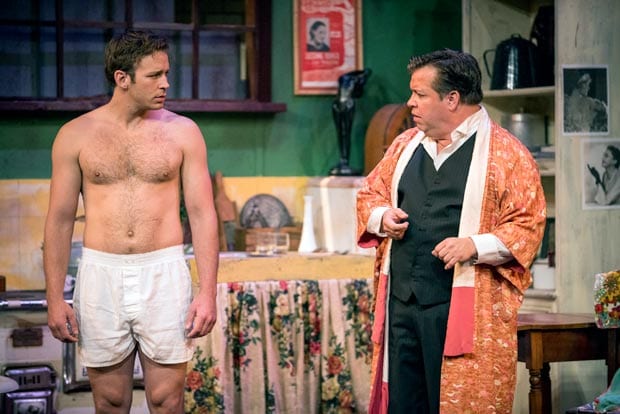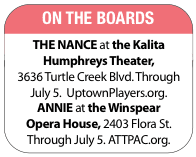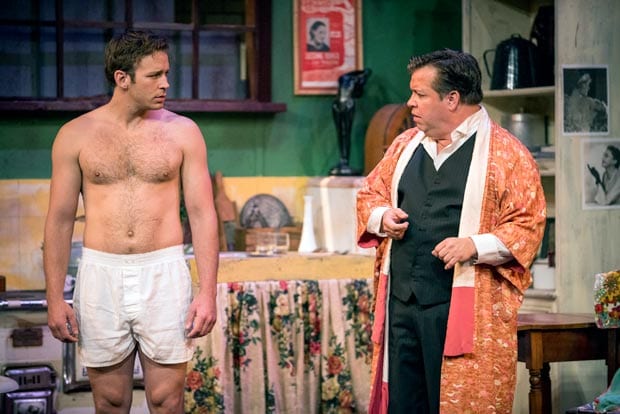Uptown Players’ impressive ‘The Nance;’ ‘Annie’ percolates with schmaltz

TRICK OF THE TRADE | A guileless redneck (Sterling Gafford) touches the heart of a self-loathing comedian (B.J. Cleveland) in this unmissable production of ‘The Nance.’ (Photo by Mike Morgan)
ARNOLD WAYNE JONES | Executive Editor
jones@dallasvoice.com
Dallas audiences are getting a good deal of the New Deal this week — both The Nance (locally produced by Uptown Players at the Kalita) and Annie (a national tour playing at the Winspear) view the 1930s through different sets of rose-colored glasses (or in Annie’s case, hollowed-out eyes).
First, the sunny side of life. Annie — a 1977 musical adaptation of the corny comic strip Little Orphan Annie, about a perpetually upbeat moppet “gee-whiskers”-ing her way through the Great Depression — has long held a reputation as among the most saccharine of all song-and-dance shows. Melodic but cloying songs like “Maybe” and the inescapable “Tomorrow” gave pre-pubescent girls the best forum to belt out a showtune until the advent of Glee. It’s ripe for mockery, what with all the dog-whistle screeching of the orphan girls in songs like “It’s a Hard-Knock Life” and “You’re Never Fully Dressed without a Smile.” A recent movie update, released at Christmas, got savaged by most critics (not me, though) because it’s such an easy show to target.
But there’s also a reason it has lasted. This touring production, which recreates the recent Broadway revival starring Jane Lynch as the conniving Miss Hannigan, has all the so-cute-you-could-strangle-them-while-they-sleep perkiness I remember from the first national tour I saw during the Carter Administration. There’s sentiment in the show, but also in seeing the show. Audiences today are probably as charmed by its longevity as audiences in 1977 were by seeing the comic strip brought to life. Why get yourself worked up hating it? It’s like punching a clown.
That said, this production makes some puzzling choices. The orchestrations are a jumble, unpredictably rushing through some parts and slowing others down to a crawl, and the cast too often garbles lines or delivers them so that the jokes don’t land. But Lynn Andrews brings a boozy-floozy vibrancy to Miss Hannigan, and the dog Sandy all but steals the show with his few appearances. That’s the measure of a schmaltzfest, I guess: When you cheer for the dog and the kid.
 New York City c. 1937 is a very different place for Chauncey Miles. Vaudeville has all but died, improv comedy clubs have not yet been discovered, and the last bastion of plying his brand of slip-on-a-banana-peel shtick and suggestive wordplay is the burlesque house. Chauncey is a star of the circuit, famed for his Nance Act — the fey, flamboyant “fairy” who makes seemingly lewd remarks but where, as he points out, all the really bad stuff is going on inside the minds of the watchers. Think drag queens with the rim shot.
New York City c. 1937 is a very different place for Chauncey Miles. Vaudeville has all but died, improv comedy clubs have not yet been discovered, and the last bastion of plying his brand of slip-on-a-banana-peel shtick and suggestive wordplay is the burlesque house. Chauncey is a star of the circuit, famed for his Nance Act — the fey, flamboyant “fairy” who makes seemingly lewd remarks but where, as he points out, all the really bad stuff is going on inside the minds of the watchers. Think drag queens with the rim shot.In Chauncey’s case, though, the nance isn’t entirely a character. He’s gay himself, forced by the conventions of the day to lurk in the shadows, picking up trade at the automat for no-real-names sex and a meek “see ya” in the morning. Despite this, he remains steadfastly Republican, a prudish conservative who opposes FDR’s “socialistic” reforms and agrees with the law-and-order stance of the populist major Fiorello LaGuardia, despite rhetoric that could bring an end to burlesque altogether.
Chauncey’s wrong, of course. He’s both self-hating and self-deluded, confident that as long as he toes the line, he and his livelihood will weather the raids and public attacks. There won’t be a “Stonewall” moment for Chauncey. Who needs the attention?
The Nance is Douglas Carter Beane’s hilariously heartbreaking metaphor for the self-immolating apathy that leads people to act in their own worst interest. Why do the working poor nowadays vote for the GOP when the GOP doesn’t really care about them? Because they can’t believe how insignificant they really are to the power structure.
It’s a serious issue, but in this sweeping play that combines history, activism and sexual politics into a single, brilliant narrative, it forces you to laugh through the tears. That’s nowhere more evident than in the play’s penultimate scene, when a defeated Chauncey performs a set that would be legendary if it weren’t such a raw wound. His pain is unfathomable.
It won’t take you until that scene, however, to be won over by B.J. Cleveland, who delivers a tour-de-force performance of such fierce humanity, it quakes you. Cleveland is North Texas’ boldest clown, a fearless performer whose intelligence, affability and sly bitterness undergird most of his work. No one can be as manic, as over-the-top, one second, then say even more with the cast of an eyebrow the next and still keep the beat.
Chauncey is Cleveland’s best role to date, even more impressive considering his resume includes memorable work as Mad King Ludwig in Valhalla to Max Bialystock in The Producers and countless other roles.
Beane’s script cannily juxtaposes behind-the-scenes insights into the characters with classic bits of burlesque comedy sketches. You might expect the corny jokes to fall flat to contemporary audiences, but funny is funny, and the cast — which also includes across-the-board excellent work from Sterling Gafford, Brett Warner, Sherry Hopkins and especially Bob Hess and Linda Leonard — delivers every joke with pathos and understanding.
Director Bruce R. Coleman’s eye for authenticity extends to every aspect of the show, which proceeds fluidly, almost dreamily, from one breathtaking moment to the next. It’s as fine a production as has been seen at the Kalita, both timely and timeless.
This article appeared in the Dallas Voice print edition June 26, 2015.

